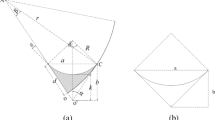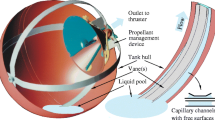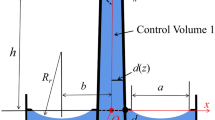Abstract
In this paper we report on the set-up and the performance of an experiment for the investigation of flow-rate limitations in open capillary channels under low-gravity conditions (microgravity). The channels consist of two parallel plates bounded by free liquid surfaces along the open sides. In the case of steady flow the capillary pressure of the free surface balances the differential pressure between the liquid and the surrounding constant-pressure gas phase. A maximum flow rate is achieved when the adjusted volumetric flow rate exceeds a certain limit leading to a collapse of the free surfaces. The flow is convective (inertia) dominated, since the viscous forces are negligibly small compared to the convective forces. In order to investigate this type of flow an experiment aboard the sounding rocket TEXUS-41 was performed. The aim of the investigation was to achieve the profiles of the free liquid surfaces and to determine the maximum flow rate of the steady flow. For this purpose a new approach to the critical flow condition by enlarging the channel length was applied. The paper is focussed on the technical details of the experiment and gives a review of the set-up, the preparation of the flight procedures and the performance. Additionally the typical appearance of the flow indicated by the surface profiles is presented as a basis for a separate continuative discussion of the experimental results.













Similar content being viewed by others
References
Brakke KA (1992) The surface evolver. Exp Math 1:141–165
Dreyer ME, Delgado A, Rath HJ (1994) Capillary rise of liquid between parallel plates under microgravity. J Colloid Interf Sci 163:158–168
Gilmore DG (1994) Satellite thermal control handbook. The Aerospace Corporation Press, El Segundo
Haake D (2004) Modellierung und Auslegung eines TEXUS-Experiments zur Untersuchung der Begrenzung des Volumenstromes in offenen Kapillarkanaelen unter Mikrogravitation. Master’s thesis, Fachbereich Produktionstechnik, Universitaet Bremen, Bremen
Hirt CW (1999) Direct computation of dynamic contact angles and contact lines. In: Proceedings of the 3rd European coating symposium ECS99, pp 85–90
Jaekle DE (1991) Propellant management device conceptual design and analysis: Vanes. In: 27th AIAA/SAE/ASME/ASEE joint propulsion conference, American Institute of Aeronautics and Astronautics, Washington, no. 91-2172 in AIAA Papers
Masica WJ (1967) Experimental investigation of liquid surface motion in response to lateral acceleration during weightlessness. Tech. Rep. NASA TN D-4066
Rollins JR, Grove RK, Jaekle DE, Lockheed Missiles and Space Co. Inc. (1985) Twenty-three years of surface tension propellant management system design, development, manufacture, test and operation. In: 21st AIAA/SAE/ASME/ASEE joint propulsion conference, American Institute of Aeronautics and Astronautics, Washington, no. 85-1199 in AIAA Papers
Rosendahl U, Ohlhoff A, Dreyer ME, Rath HJ (2002) Investigation of forced liquid flows in open capillary channels. Microgravity Sci Technol XIII/4:53–59
Rosendahl U, Ohlhoff A, Dreyer ME (2004) Choked flows in open capillary channels: theory, experiment and computations. J Fluid Mech 518:187–214
Srinivasan R (2003) Estimating zero-g flow rates in open channels having capillary pumped vanes. Int J Numer Methods Fluids 41:389–417
Acknowledgments
The funding of the sounding rocket flight and the research project by the German Ministry of Education and Research (BMBF) through the German Aerospace Center (DLR) under grant numbers 50WM0421 and 50WM0535 is gratefully acknowledged. The experiment hardware has been build by EADS ST in Bremen and the authors thank D. Grothe and J.-P. Kunst for their support. We further wish to thank D. Haake and J. Klatte for the performance of the numerical calculations and P. Prengel for valuable technical comments.
Author information
Authors and Affiliations
Corresponding author
Rights and permissions
About this article
Cite this article
Rosendahl, U., Dreyer, M.E. Design and performance of an experiment for the investigation of open capillary channel flows. Exp Fluids 42, 683–696 (2007). https://doi.org/10.1007/s00348-007-0274-6
Received:
Revised:
Accepted:
Published:
Issue Date:
DOI: https://doi.org/10.1007/s00348-007-0274-6




